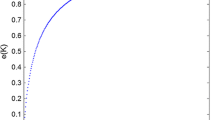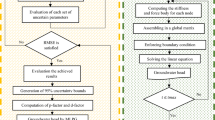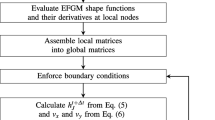Abstract
We explore the ability of the greedy algorithm to serve as an effective tool for the construction of reduced-order models for the solution of fully saturated groundwater flow in the presence of randomly distributed transmissivities. The use of a reduced model is particularly appealing in the context of numerical Monte Carlo (MC) simulations that are typically performed, e.g., within environmental risk assessment protocols. In this context, model order reduction techniques enable one to construct a surrogate model to reduce the computational burden associated with the solution of the partial differential equation governing the evolution of the system. These techniques approximate the model solution with a linear combination of spatially distributed basis functions calculated from a small set of full model simulations. The number and the spatial behavior of these basis functions determine the computational efficiency of the reduced model and the accuracy of the approximated solution. The greedy algorithm provides a deterministic procedure to select the basis functions and build the reduced-order model. Starting from a single basis function, the algorithm enriches the set of basis functions until the largest error between the full and the reduced model solutions is lower than a predefined tolerance. The comparison between the standard MC and the reduced-order approach is performed through a two-dimensional steady-state groundwater flow scenario in the presence of a uniform (in the mean) hydraulic head gradient. The natural logarithm of the aquifer transmissivity is modeled as a second-order stationary Gaussian random field. The accuracy of the reduced basis model is assessed as a function of the correlation scale and variance of the log-transmissivity. We explore the performance of the reduced model in terms of the number of iterations of the greedy algorithm and selected metrics quantifying the discrepancy between the sample distributions of hydraulic heads computed with the full and the reduced model. Our results show that the reduced model is accurate and is highly efficient in the presence of a small variance and/or a large correlation length of the log-transmissivity field. The flow scenarios associated with large variances and small correlation lengths require an increased number of basis functions to accurately describe the collection of the MC solutions, thus reducing significantly the computational advantages associated with the reduced model.
Similar content being viewed by others
References
Dagan, G.: Flow and Transport in Porous Formations. Springer, New York (1989)
Zhang, D.: Stochastic Methods for Flow in Porous Media: Copying with Uncertainties. Academic, San Diego (2002)
Yustres, A., Asensio, L., Alonso, J., Navarro, V.: A review of Markov Chain Monte Carlo and information theory tools for inverse problems in subsurface flow. Comput. Geosci. 16(1), 1–20 (2012). doi:10.1007/s10596-011-9249-z
Moradkhani, H., DeChant, C.M., Sorooshian, S.: Evolution of ensemble data assimilation for uncertainty quantification using the particle filter-Markov chain Monte Carlo method. Water Resour. Res. 48(12), W12520 (2012). doi:10.1029/2012WR012144
Guadagnini, A., Neuman, S.P.: Nonlocal and localized analyses of conditional mean steady state flow in bounded, randomly nonuniform domains: 1. Theory and computational approach. Water Resour. Res. 35(10), 2999–3018 (1999). doi:10.1029/1999WR900160
Winter, C.L., Tartakovsky, D.M., Guadagnini, A.: Moment differential equations for flow in highly heterogeneous porous media. Surv. Geophys. 24(1), 81–106 (2003). doi:10.1023/A:1022277418570
Panzeri, M., Riva, M., Guadagnini, A., Neuman, S.P.: Data assimilation and parameter estimation via ensemble Kalman filter coupled with stochastic moment equations of transient groundwater flow. Water Resour. Res. 49, 1334–1344 (2013). doi:10.1002/wrcr.20113
Sanchez-Vila, X., Fernandez-Garcia, D., Guadagnini, A.: Conditional probability density functions of concentrations for mixing-controlled reactive transport in heterogeneous aquifers. Math. Geosci. 41, 323–351 (2009). doi:10.1007/s11004-008-9204-2
Tartakovsky, D.M., Dentz, M., Lichtner, P.C.: Probability density functions for advective-reactive transport in porous media with uncertain reaction rates. Water Resour. Res. 45, W07414 (2009). doi:10.1029/2008WR007383
Dentz, M., Tartakovsky, D.M.: Probability density functions for passive scalars dispersed in random velocity fields. Geophys. Res. Lett. 45, L24406 (2010). doi:10.1029/2010GL045748
Venturi, D., Tartakovsky, D.M., Tartakovsky, A.M., Karniadakis, G.E.: Exact pdf equations and closure approximations for advective-reactive transport. J. Comput. Phys. 243, 323–343 (2013). doi:10.1016/j.jcp.2013.03.001
Ballio, F., Guadagnini, A.: Convergence assessment of numerical Monte Carlo simulations in groundwater hydrology. Water Resour. Res. 40, W04603 (2004). doi:10.1029/2003WR002876
Pasetto, D., Guadagnini, A., Putti, M.: POD-based Monte Carlo approach for the solution of regional scale groundwater flow driven by randomly distributed recharge. Adv. Water Resour. 34(11), 1450–1463 (2011). doi:10.1016/j.advwatres.2011.07.003
Zhang, D., Lu, Z.: An efficient, high-order perturbation approach for flow in random porous media via Karhunen-Loève and polynomial expansions. J. Comput. Phys. 194(2), 773–794 (2004). doi:10.1016/j.jcp.2003.09.015
Poles, S., Lovison, A.: A polynomial chaos approach to robust multiobjective optimization. In: Deb, K., et al. (eds.) Hybrid and Robust Approaches to Multiobjective Optimization, number 09041 in Dagstuhl Seminar Proceedings. Schloss Dagstuhl - Leibniz-Zentrum fuer Informatik, Germany, Dagstuhl (2009)
Oladyshkin, S., Class, H., Helmig, R., Nowak, W.: An integrative approach to robust design and probabilistic risk assessment for CO2 storage in geological formations. Comput. Geosci. 15(3), 565–577 (2011). doi:10.1007/s10596-011-9224-8
Formaggia, L., Guadagnini, A., Imperiali, I., Lever, V., Porta, G., Riva, M., Scotti, A., Tamellini, L.: Global sensitivity analysis through polynomial chaos expansion of a basin-scale geochemical compaction model. Comput. Geosci. 17, 25–42 (2013). doi:10.1007/s10596-012-9311-5
Li, H., Zhang, D.: Probabilistic collocation method for flow in porous media: comparisons with other stochastic methods. Water Resour. Res. 43, W09409 (2007). doi:10.1029/2006WR005673
Kunisch, K., Volkwein, S.: Galerkin proper orthogonal decomposition methods for a general equation in fluid dynamics. SIAM J. Numer. Anal. 40, 492–515 (2002). doi:10.1137/S0036142900382612
Siade, A.J., Putti, M., Yeh, W.W.-G.: Snapshot selection for groundwater model reduction using proper orthogonal decomposition. Water Resour. Res. 46, W08539 (2010). doi:10.1029/2009WR008792
Grepl, M.A., Patera, A.T.: A posteriori error bounds for reduced-basis approximations of parametrized parabolic partial differential equations. ESAIM-Math Model. Num. 39(1), 157–181 (2005). doi:10.1051/m2an:2005006
Quarteroni, A., Rozza, G., Manzoni, A.: Certified reduced basis approximation for parametrized partial differential equations and applications. Math. Indust. 1(1), 1–49 (2011). doi:10.1186/2190-5983-1-3
Siade, A.J., Putti, M., Yeh, W.W.-G.: Reduced order parameter estimation using quasilinearization and quadratic programming. Water Resour. Res. 48, W06502 (2012). doi:10.1029/2011WR011471
Kaleta, M.P., Hanea, R.G., Heemink, A.W., Jansen, J.-D.: Model-reduced gradient-based history matching. Comput. Geosci. 15(1), 135–153 (2011). doi:10.1007/s10596-010-9203-5
van Doren, J.F.M., Markovinović, R., Jansen, J.-D.: Reduced-order optimal control of water flooding using proper orthogonal decomposition. Comput. Geosci. 10(1), 137–158 (2006). doi:10.1007/s10596-005-9014-2
Pasetto, D., Putti, M., Yeh, W.W.-G.: A reduced order model for groundwater flow equation with random hydraulic conductivity: application to Monte Carlo methods. Water Resour. Res. 49, 1–14 (2013). doi:10.1002/wrcr.20136
Müller, F., Jenny, P., Meyer, D.W.: Multilevel Monte Carlo for two phase flow and Buckley-Leverett transport in random heterogeneous porous media. J. Comput. Phys. (2013). doi:10.1016/j.jcp.2013.03.023
Lieberman, C., Willcox, K., Ghattas, O.: Parameter and state model reduction for large-scale statistical inverse problems. SIAM J. Sci. Comput. 32(5), 2523–2542 (2010). doi:10.2307/2236101
Bellin, A., Rubin, Y.: HYDRO_GEN: a spatially distributed random field generator for correlated properties. Stoch. Hydrol. Hydraul. 10(4), 253–278 (1996). doi:10.1007/BF01581869
Author information
Authors and Affiliations
Corresponding author
Rights and permissions
About this article
Cite this article
Pasetto, D., Guadagnini, A. & Putti, M. A reduced-order model for Monte Carlo simulations of stochastic groundwater flow. Comput Geosci 18, 157–169 (2014). https://doi.org/10.1007/s10596-013-9389-4
Received:
Accepted:
Published:
Issue Date:
DOI: https://doi.org/10.1007/s10596-013-9389-4




